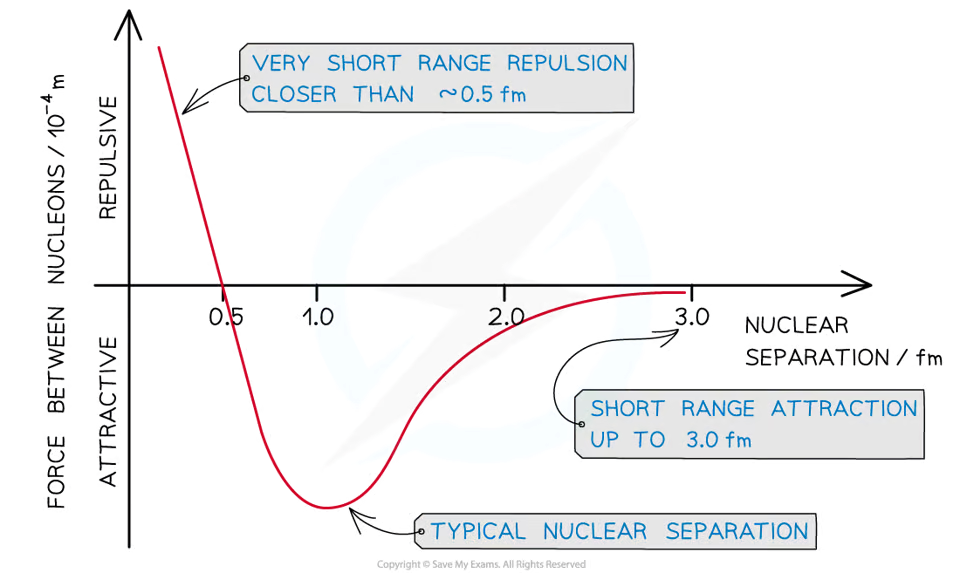IB Physics Unit 7 Structure of Matter (Quarks, Leptons, Mesons, Baryons, Protons, Fundamental Forces). SME 7.3
1/93
Earn XP
Description and Tags
for May 2024 syllabus
Name | Mastery | Learn | Test | Matching | Spaced |
|---|
No study sessions yet.
94 Terms
Quark
Fundamental particles; make up protons and neutrons
Hadron
any particle made up of quarks
Examples of Hadrons
Protons and Neutrons
Proton
uud
Neutron
udd
u
Up
c
Charm
t
Top
d
Down
s
Strange
b
Bottom
Relative charge for quarks ‘uct’
+2/3e
Relative charge for quarks ‘dsb’
-1/3e
Baryons
constructed of 3 quarks
Example of Baryons
protons and neutrons
Mesons
quark and anti quark pair
Fundamental
Not made up of any other particles
Examples of fundamental particles
Electrons, Quarks
Strangeness of Strange quark
-1
Leptons
Fundamental particles
e-
electrons
μ-
Muon
𝜏-
Tau
Ve
electron neutrino
Vμ
Muon Neutrino
V𝜏
Tau Neurino
Charge of 𝜏-, μ- & e-
0.0005u
Emitted with electrons (during beta decay)
Electron-Neutrino
Emitted with Muons
Muon-Neutrino
Emitted with Tau
Tau-Neutrino
Leptons Interact with:
Weak interaction, electromagnetic and gravitational forces
Leptons Do Not interact with:
Strong force
Up Antiparticle
Anti-Up
Charm Antiparticle
Anti-Charm
Top Antiparticle
Anti-top
Down Antiparticle
Anti-Down
Strange Antiparticle
Anti-Strange
Bottom Antiparticle
Anti-Bottom
Charge of Anti-Quarks
Reverse symbol of charge
Denotation of Anti-Quarks
Add dash directly on top of symbol
Lepton Number
Number of laptons in an interaction
Baryon Number of quarks
+1/3
Baryon Number of anti quarks
-1/3
Lepton Number of Leptons
+1
Lepton Number of Anti-Leptons
-1
Lepton Number of Any Particle that is not a Lepton
0
Rule of Lepton Number
Lepton Number is Conserved in all interactions
Protons Stability as Baryons
The most Stable Baryon
Protons Half Life as Baryon
Longest Half-life of any Baryon
Protons Relationship between Baryon stability and mass
Protons are the most Stable baryons as a result of them also being the lightest Baryon.
Proton Half-Life order of magnitude
10³² Years
Electron Antiparticle e+
Positron
Beta Decay occurs through…
The Weak Interaction
Four fundamental Forces
Gravity, Electromagnetism, Strong and Weak Nuclear Forces
Summary of Beta- decay
A neutron turns into a proton emitting an electron and antineutrino
In depth of Beta Decay
Neutron turns into proton because
a down quark turns into an up quark
Summary of Beta+ Decay
A proton turns into a neutron emitting a positron and an electron neutrino
In depth of Beta Decay
A proton turns into a neutron because
an up quark turns into a down quark
Hadrons
Subatomic particles made of quarks
Hadrons idenitty
Either Baryon or Mesons
Hadrons Antiparticle
Anti-Hadrons
Anti-Hadrons identity
Anti-Baryons or Anti-mesons
Hadrons and Mesons important note
All possess an Integer (Whole Number) charge
e.g +1e,
Baryon important note
Combinations of quarks and anti quarks do not exist.
Baryon Number B
Number of Baryons in an interaction
Baryon number of Baryons
B = +1
Baryon Number of Anti-Baryons
B = - 1
Baryon Number of Non-Baryons`
B = 0
Rule of Baryon Number
It is conserved.
Baryon number of Quarks Up Down Stange
1/3
Baryon number of Anti Up, Anti Down, and Anti - Strange
-1/3
Baryon Number of Mesons
B = 0
Examples of Mesons
Pions, Kaons, D mesons, B mesons
Pions Charge information
Can be positive, negative or neutral
Pion Antiparticle
Negative pion
Pions mass and stability
Lightest mesons, and therefore most stable
discovery of pions
discovered in cosmic rays
Pions
Exchange particles of the strong nuclear force
Positive pion
up + anti down
neutral pion
up + anti up | down + anti down
negative pion
anti up + down
Kaons
heavy unstable mesons which normally decay into pions
Conservation of strangeness
Not conserved, Nonexistent
Bosons
“Wingman” particles which mediate interactions based on the four fundamental forces
Mediator of Gravitational Forces
Graviton
Mediator of Weak Forces
W+ W- & Z { W-Bosons & Z-Bosons
Mediator of Electromagnetic Forces
Photons γ
Mediator of Strong Nuclear Forces
Gluons (Between quarks) and Plons (between nucleons)
Strong Nuclear forces and Leptons
Leptons Cannot interact with the strong nuclear force, since they are not made of quarks

Graphical interpretation of Strong nuclear force
Becomes zero after 3.0fm
Repulsive (of strong forces)
closer than 0.5fm
Attractive (of strong forces)
up to around 3.0 fm
Exchange particles
Temporary particles that mediate/carry/transmit a fundamental force between interacting particles
The Higgs-Boson
A particle responsible for the mass of all other particles